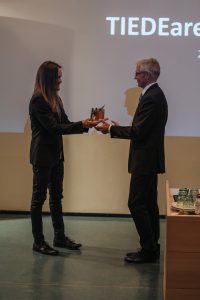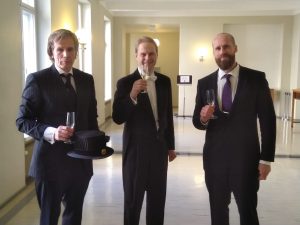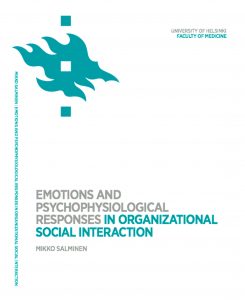Congratulations to GG members’ achievements
Last week the Gamification Group celebrated the great achievements of two of our group members!
Congratulations to Juho Hamari, who was selected as the Researcher of the Year, selected between Tampere University of Technology, University of Turku, University of Tampere and Aalto University at UC Pori.
Pictures by “Sofia Malinen and Markus Ketola”
For more information, please visit: http://www.ucpori.fi/uutiset/juho-hamarista-vuoden-tutkija-tiedekilpailun-voitto-psylin-lukioon
And also congratulations to Mikko Salminen, who successfully defended his thesis on “Emotions and psychophysiological responses in organizational social interaction”.

From left: prof. Niklas Ravaja, prof. Lauri Nummenmaa and Mikko Salminen.
For more information, please visit: https://www.helsinki.fi/fi/uutiset/terveys/tunteet-tarttuvat-tyoelamassa-myos-teknologian-valityksella

Cover picture of Mikko’s dissertation
Abstract
Emotions have various effects on work life and organizational social interaction.
Daily work events evoke emotional reactions, which are communicated, either intentionally or unintentionally, to colleagues and clients. These communicated emotions may evoke corresponding affective responses in the perceiver, thus making the emotions social. An existing emotional state may affect the performance of work tasks such as decision-making. It may also affect social interaction, regardless of whether it happens face-to-face or is mediated by some communication technology. The hierarchical nature of organizations may often also result in implicit rules regarding the expression of certain emotions, depending on one’s social status.
This dissertation uses self-reports and psychophysiological measurements to study emotions in organizational social interaction, in both controlled laboratory experiments and field studies in actual work settings. The four studies of the dissertation focus on two research lines: 1) The dispositional effects of personality and trait emotional intelligence on emotions during dyadic face-to-face social interaction, and 2) Emotional processes during technology-mediated social interaction when conducting work tasks such as planning and decision-making.
The current dissertation focuses on the emotions on four of the five organizational levels of Ashkanasy’s (2003) model, namely the Within-person level, Between-person level, Interpersonal interaction level, and Group and team level. The work is organized into six research questions, which address the relationship between emotional expressions and internal motivation state, behavior in a social decision- making task, the role of trait emotional intelligence and personality in emotional processes during organizational face-to-face social interaction, emotional contagion and emotion regulation in technology-mediated social interaction, and the effects of a technology-mediated group emotional state on the individual.
Regarding the first research question, the research showed how during a social decision-making task with a computer-controlled virtual character, the participant’s facial muscle activation, which is indicative of negative valence emotional expressions, was related to their decision to defect the possibility of cooperation. This defection enabled a higher pay-off in the task; the frontal asymmetry of the electroencephalogram, indexing approach motivation, was related to the anticipated high pay-off achievement rather than to establishing cooperation. During a performance review discussion, both trait emotional intelligence and the matching levels of the Extraversion personality dimension was related to self-reports and physiological activity, indicating a positive valence emotional state, thus contributing to the second and third research questions. As regards the fourth research question, the results showed that emotional contagion occurred from a virtual character, as well as within a distributed group, via a technology-mediated cue of group emotional state. We also observed emotion regulation in the participant when they interacted with a virtual character, thus contributing to the fifth research question. Finally, the sixth research question was addressed by showing that contagious negative group emotional state had detrimental effects on confidence in the group.
In sum, this dissertation contributes to the field of organizational social psychology by showing the viability of the quantitative method of psychophysiology in the study of organizational behavior in real-life contexts.
On October 2, in the beginning of Gamification Group monthly meeting, all GG members gathered to celebrate Juho’s and Mikko’s achievements.




Sorry, the comment form is closed at this time.